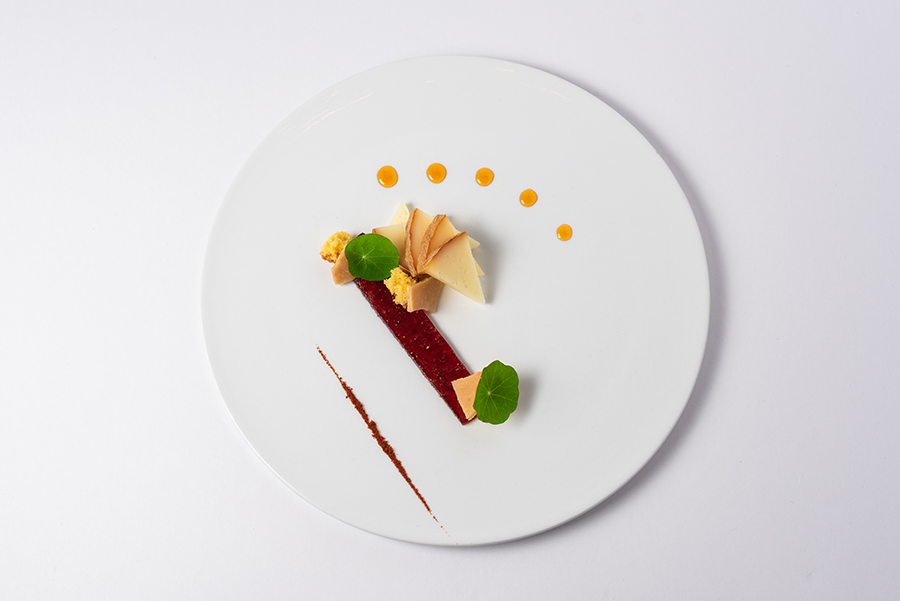I’ll admit that even as a pastry chef, sometimes the last thing I’m looking for in a “last course” is something sweet. While I think it’s important to always save room for dessert, I’m often swayed by the alternative of a composed cheese course. At the very least, I may even squeeze the cheese in before dessert!
From a creative perspective, a composed cheese plate allows an exciting opportunity to straddle the line that separates sweet from savory. The cheese is the star of the show, of course, but the accompaniments we choose can play an important role as supporting actors. I often try to start with a palette of basic tastes – sweet, salty, bitter, acid – as inspiration and follow that with spice or heat; the balance of these elements will, of course, be determined by the flavors offered by the cheese.
To demonstrate this approach, we could start with a favorite of mine, Petit Basque. Produced in the French Pyrenees, it’s a semi-firm sheep’s milk cheese that is nutty, earthy and occasionally accompanied by just a hint of funkiness. For one, it’s formed into diminutive cylinders and is firm enough to cut into clean slices, which lends itself well to a plated composition. As I start to explore the range of supporting flavors at my disposal, I really need to look no further than the region the cheese hails from – the vibrant Basque country that incorporates parts of France and Spain.
I love the notion that what grows together, goes together, so when I think of the south of France and northern Spain, I’m immediately drawn to flavors like fig and almond. The richness of the Petit Basque could stand up to a hint of spice, so a smoky pimenton is an obvious choice. For some complex acidity, I love the classic gastrique – essentially a caramel made with vinegar – and a bright peach vinegar would add even more interesting fruit notes. Confit lemon peel adds a final sweet-bitter-acid touch that helps tie all the components together.
As soon as the flavors begin to come into focus, I’m already thinking of what form they might take. While some cheeses are special enough on their own to not require much fussy treatment, our milky Petit Basque begs for a bit more compositional flair. The fig is cooked down into a pate de fruit and sliced in a long, thin base. Salty Marcona almonds are presented both unadorned and fashioned into a crunchy shard of praline. A line of the smoked paprika allows the guest to play with different heat levels in each bite. And after a few drops of the sweet-sour peach gastrique, a peppery nasturtium leaf becomes the final garnish.
A composed cheese plate not only enhances subtle nuances of its noble subject but also affords a chance to flex our culinary muscles to elevate such pairings and to customize a range of complementary flavors and textures.


Ingredients
For the Petit Basque:
- Fig Pâte de Fruit (recipe below)
- Marcona Almond Praline (recipe below)
- Peach Vinegar Gastrique (recipe below)
- Confit Lemon Peel
- Spanish Pimenton
- Marcona Almonds, whole
- Nasturtium Leaf
For the fig pâte de fruit:
- 200 grams fig purée
- 50 grams apricot purée
- 30 grams sucrose (1)
- 4 grams yellow pectin
- 210 grams sucrose (2)
- 40 grams glucose syrup
- 3.5 grams citric acid
For the Marcona almond praline:
- 56 grams unsalted butter
- 85 grams sucrose
- 12 grams glucose syrup
- 12 grams water
- 40 grams Marcona almond (roasted and salted), coarsely ground
For the peach vinegar gastrique:
- 125 grams sucrose
- 75 grams water
- 30 grams peach vinegar
Directions
For the fig pâte de fruit:
- In a heavy saucepan, combine purées and heat to 40 C/104 F.
- Combine first measurement of sucrose (1) and pectin and whisk into purées. Bring to a boil, stirring continuously.
- Add remaining sucrose (2) and glucose. Cook to 106 C/223 F. Remove from heat and stir in citric acid.
- Pour into a plastic-lined 12-centimeter square frame and allow to set.
For the Marcona almond praline:
- Melt the butter in a small heavy saucepan. Remove from heat and stir in sucrose, glucose syrup and water. Cook, stirring occasionally until the mixture reaches 150 C/300 F.
- Remove from heat, stir in almonds and pour out on buttered parchment-lined half-sheet pan or marble to cool and harden.
For the peach vinegar gastrique:
- Combine sucrose and water to moisten in a small saucepan. Cook to a very light caramel color.
- Remove from heat and slowly add vinegar. Return to heat and cook to dissolve any hardened bits of sugar. Continue to cook to 105 C/221 F. Allow to cool.
Train with award-winning pastry chefs in ICE's Pastry & Baking Arts program.




